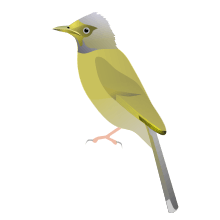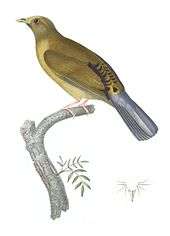Grey-headed bulbul
| Grey-headed bulbul | |
|---|---|
 | |
| Call | |
| Scientific classification | |
| Kingdom: | Animalia |
| Phylum: | Chordata |
| Class: | Aves |
| Order: | Passeriformes |
| Family: | Pycnonotidae |
| Genus: | Pycnonotus |
| Species: | P. priocephalus |
| Binomial name | |
| Pycnonotus priocephalus (Jerdon, 1839) | |
 | |
| Synonyms | |
|
Brachypus priocephalus | |
The grey-headed bulbul (Pycnonotus priocephalus) is a member of the bulbul family of passerine birds. It is endemic to the Western Ghats of south-west India, found from Goa south to Tamil Nadu, at altitudes up to 1200m. It is found in dense reeds or thickets mainly near rivers and swampy areas inside forests. They have a distinctive call that reveals their presence inside dense vegetation that makes them hard to spot. Their taxonomic position within the bulbuls is not clear.
Description

This bulbul is resident in moist broadleaved evergreen forest with bamboo and dense undergrowth. Its plumage is olive-green, with a medium-grey on the crown head, nape and throat. The forehead is yellow-green. The back, wings are olive green becoming lighter towards the vent. The rump has yellowing green feathers edged in black giving a barred appearance. The flanks are dark and grey edged. The undertail coverts are gray. The beak is greenish and grey while the legs are pinkish yellow. The iris is distinctly bluish white. The tail is grey on the central feathers (the shaft being black), the outer ones are black and are broadly tipped with grey. Both sexes are similar but juveniles have the head dark olive with the yellow on the forehead duller. (Length 143-152mm; head 33-35mm; tail 74-77mm)[3][4][5]
Found singly or in small groups. Breeds from January to June with a peak in April. The nest is a typical platform placed inside a low bush. The typical clutch is one egg or sometimes two eggs that are incubated for 12 to 14 days. The nestlings leave the nest after 11 to 13 days. The eggs are pale pink to lavender and flecked in red, more densely on the broad end.[6] Both parents take part in incubation and feeding.[7] Feeds mainly on fruits. Call is a sharp chraink.[3]
Taxonomy and systematics

The species was described by Thomas Jerdon under the name of Brachypus priocephalus but said to have been "emended" in error by Edward Blyth to Brachypodius poiocephalus and the confusion carried forward in literature.[4][8][9][10]
The call is distinct in having a single syllable unlike those of the core Pycnonotus genus members.[3] The genus Pycnonotus as currently defined has been identified as polyphyletic and the genus placement for this species may change in the future. This species has not been used in recent molecular phylogeny studies of the group.[11]
Behaviour and ecology
The diet consists mainly of fruits (>65%) and invertebrates (>30%). Fruits include those of Symplocos cochinchinensis, Antidesma menasu, Clerodendrum viscosum, Syzygium cumini, Litsea floribunda, Maesa indica, Callicarpa tomentosa, Leea indica and Lantana camara. Grey-headed bulbuls actively join mixed-species foraging flocks during the non-breeding season. The breeding season is between January to May. The build their nest over a period of a week using vines, grasses or leaves. Many nests in a study in the Silent Valley National park were found to be made on saplings of Syzygium species or in reeds of Ochlandra travancorica. The typical clutch was two eggs which were incubated for about 14 days. The young fledge in about 12 days. Eggs are sometimes destroyed and eaten by palm squirrels (Funambulus tristriatus).[12][13][14][15]
References
- ↑ BirdLife International (2012). "Pycnonotus priocephalus". IUCN Red List of Threatened Species. Version 2013.2. International Union for Conservation of Nature. Retrieved 26 November 2013.
- ↑ Eydoux F, L FASouleyet (1841). Voyage Autour du Monde sur la Corvette La Bonite. Paris: Arthus Bertrand. pp. 86–88.
- 1 2 3 Rasmussen, P.C.; J.C. Anderton (2005). Birds of South Asia: the Ripley guide. 2. Smithsonian Institution & Lynx Edicions. pp. 335–336. ISBN 84-87334-67-9.
- 1 2 Jerdon TC (1863). The birds of India. Volume 2 part 1. Military Orphan Press, Calcutta. p. 89.
- ↑ Oates, EW (1889). Fauna of British India. Birds Volume 1. Taylor and Francis, London. p. 296.
- ↑ Ali S; SD Ripley (1996). Handbook of the birds of India and Pakistan. 6 (2nd ed.). Oxford University Press. pp. 70–71.
- ↑ Balakrishnan Peroth (2010). "Parental care strategies of grey-headed bulbul, Pycnonotus priocephalus in the Western Ghats, South India" (PDF). Current Science. 98 (5): 673–680.
- ↑ Dickinson, E.C.; R.W.R.J. Dekker; S. Eck & S. Somadikarta (2002). "Systematic notes on Asian birds. 26. Types of the Pycnonotidae". Zool. Verh. Leiden. 340: 115–160.
- ↑ Baker, ECS (1930). Fauna of British India. Birds. 7 (2nd ed.). Taylor and Francis, London. p. 88.
- ↑ Baker, ECS (1922). Fauna of British India. Birds Volume 1. Taylor and Francis, London. pp. 425–426.
- ↑ Moyle RG; BD Marks (2006). "Phylogenetic relationships of the bulbuls (Aves: Pycnonotidae) based on mitochondrial and nuclear DNA sequence data" (PDF). Molecular Phylogenetics and Evolution. 40 (3): 687–695. doi:10.1016/j.ympev.2006.04.015. PMID 16750401.
- ↑ Vijayan, V.S., and Balakrishnan, Peroth. (2005). Status, Distribution and Ecology of the Grey-headed Bulbul Pycnonotus priocephalus in Western Ghats, India. Final Report submitted to Ministry of Environment and Forests, Govt. of India. Sálim Ali Centre for Ornithology Natural History, Coimbatore.
- ↑ Balakrishnan, Peroth. (2007). Status, distribution and ecology of Grey-headed Bulbul Pycnonotus priocephalus in the Western Ghats, India. PhD thesis. Bharathiar University, Coimbatore.
- ↑ Balakrishnan, Peroth. (2011). "Breeding biology of the Grey-headed Bulbul Pycnonotus priocephalus (Aves: Pycnonotidae) in the Western Ghats, India" (PDF). Journal of Threatened Taxa. 3 (1): 1415–1424. doi:10.11609/jott.o2381.1415-24.
- ↑ Balakrishnan, Peroth (2014). "Foraging behaviour of the Near Threatened Grey-headed Bulbul Pycnonotus priocephalus in relation to seasons and breeding stages". Journal of Bombay Natural History Society. 111 (1): 10–18. doi:10.17087/bnhs/2014/v111i1/56520.
External links
| Wikimedia Commons has media related to Pycnonotus priocephalus. |
